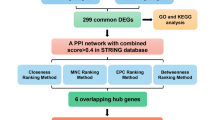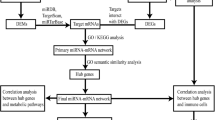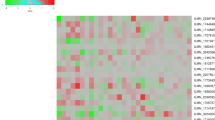Abstract
Network analysis and visualization of genes are very important to understand large complex biological data in a better manner. Large data on genes and proteins in the biological systems are analyzed on the occurrence, interactions, co-expression, and co-regulations of various genes. Here we have visualized the genes involved in type 1 diabetes (T1D), type 2 diabetes (T2D), and foot ulcer condition to put light on the corrective measures to the problem of impaired healing. The goal of this study was to identify the important genes involved in the pathogenesis of diabetes complications and foot ulcer and its association with the free radical-producing enzyme, the myeloperoxidase (MPO). In this study, we have used bioinformatics tools for the analysis of 24 genes that play a major role in diabetes mellitus and its complications, especially diabetic foot ulcer to reveal the relation between the genes and proteins involved in these disease conditions. We could conclude from the network model that MPO is related to foot ulcer and involved in pathogenesis of various co-associated diseases, such as oxidative stress, inflammation, peripheral vascular disease, and other related diabetes complications.




Similar content being viewed by others
References
Bowering CK (2001) Diabetic foot ulcers. Pathophysiology, assessment, and therapy. Can Fam Physician (Medecin de famille canadien) 47(5):1007–1016
Xu F, Zhang C, Graves DT (2013) Abnormal cell responses and role of TNF-alpha in impaired diabetic wound healing. Biomed Res Int 2013:754802. doi:10.1155/2013/754802
Falanga V (2005) Wound healing and its impairment in the diabetic foot. Lancet 366(9498):1736–1743. doi:10.1016/S0140-6736(05)67700-8
Perschel WT, Langefeld TW, Federlin K (1995) Susceptibility to infections in diabetes—effects on metabolism. Immun Infekt 23(6):196–200
Brem H, Tomic-Canic M (2007) Cellular and molecular basis of wound healing in diabetes. J Clin Investig 117(5):1219–1222. doi:10.1172/JCI32169
Klebanoff SJ (2005) Myeloperoxidase: friend and foe. J Leukoc Biol 77(5):598–625. doi:10.1189/jlb.1204697
Rebhan M, Chalifa-Caspi V, Prilusky J, Lancet D (1998) GeneCards: a novel functional genomics compendium with automated data mining and query reformulation support. Bioinformatics 14(8):656–664
Queralt-Rosinach N, Furlong LI (2013) DisGeNET RDF: a gene-disease association linked open data resource. In: Paschke A, Burger A, Romano P, Marshall MS, Splendiani A (eds) Proceedings of the 6th international workshop on semantic web applications and tools for life sciences (SWAT4LS 2013), Edinburgh, UK
Ashburner M, Ball CA, Blake JA, Botstein D, Butler H, Cherry JM, Davis AP, Dolinski K, Dwight SS, Eppig JT, Harris MA, Hill DP, Issel-Tarver L, Kasarskis A, Lewis S, Matese JC, Richardson JE, Ringwald M, Rubin GM, Sherlock G (2000) Gene ontology: tool for the unification of biology. The Gene Ontology Consortium. Nat Genet 25(1):25–29. doi:10.1038/75556
Franceschini A, Szklarczyk D, Frankild S, Kuhn M, Simonovic M, Roth A, Lin J, Minguez P, Bork P, von Mering C, Jensen LJ (2013) STRING v9.1: protein–protein interaction networks, with increased coverage and integration. Nucleic Acids Res 41(Database issue):D808–D815. doi:10.1093/nar/gks1094
Kanehisa M, Goto S (2000) KEGG: kyoto encyclopedia of genes and genomes. Nucleic Acids Res 28(1):27–30
Shannon P, Markiel A, Ozier O, Baliga NS, Wang JT, Ramage D, Amin N, Schwikowski B, Ideker T (2003) Cytoscape: a software environment for integrated models of biomolecular interaction networks. Genome Res 13(11):2498–2504. doi:10.1101/gr.1239303
Werner S, Grose R (2003) Regulation of wound healing by growth factors and cytokines. Physiol Rev 83(3):835–870. doi:10.1152/physrev.00031.2002
Bohova J, Majtan J, Takac P (2012) Immunomodulatory properties of medicinal maggots Lucilia sericata in wound healing process. Tang 2(3):23.21–23.27. doi:10.5667/tang.2012.0025
Reihmane D, Jurka A, Tretjakovs P (2012) The relationship between maximal exercise-induced increases in serum IL-6, MPO and MMP-9 concentrations. Scand J Immunol 76(2):188–192. doi:10.1111/j.1365-3083.2012.02720.x
Franconi F, Di Leo MAS, Bennardini F, Ghirlanda G (2004) Is taurine beneficial in reducing risk factors for diabetes mellitus? Neurochem Res 29(1):143–150
Schaffer SW, Azuma J, Mozaffari M (2009) Role of antioxidant activity of taurine in diabetes. Can J Physiol Pharmacol 87(2):91–99. doi:10.1139/Y08-110
Arnhold J, Flemmig J (2010) Human myeloperoxidase in innate and acquired immunity. Arch Biochem Biophys 500(1):92–106. doi:10.1016/j.abb.2010.04.008
Das UN (2011) Molecular basis of health and disease. Springer, Dordrecht
Kumar AP, Ryan C, Cordy V, Reynolds WF (2005) Inducible nitric oxide synthase expression is inhibited by myeloperoxidase. Nitric Oxide Biol Chem Off J Nitric Oxide Soc 13(1):42–53. doi:10.1016/j.niox.2005.04.002
Astern JM (2007) Myeloperoxidase in vascular disease and autoimmunity. University of North Carolina, Chapel Hill
Ceriello A (2003) New insights on oxidative stress and diabetic complications may lead to a “causal” antioxidant therapy. Diabetes Care 26(5):1589–1596
Ishibashi T, Kawaguchi M, Sugimoto K, Uekita H, Sakamoto N, Yokoyama K, Maruyama Y, Takeishi Y (2010) Advanced glycation end product-mediated matrix metallo-proteinase-9 and apoptosis via renin-angiotensin system in type 2 diabetes. J Atheroscler Thromb 17(6):578–589
Tiruppathi C, Naqvi T, Wu Y, Vogel SM, Minshall RD, Malik AB (2004) Albumin mediates the transcytosis of myeloperoxidase by means of caveolae in endothelial cells. Proc Natl Acad Sci USA 101(20):7699–7704. doi:10.1073/pnas.0401712101
Agner K (1970) Biological effects of hypochlorous acid formed by” MPO”-peroxidation in the presence of chloride ions. Structure and function of oxidation–reduction enzymes. Elsevier, Wenner-Gren Center, Stockholm
Mates JM (2000) Effects of antioxidant enzymes in the molecular control of reactive oxygen species toxicology. Toxicology 153(1–3):83–104
Nieman GF, Zerler BR (2001) A role for the anti-inflammatory properties of tetracyclines in the prevention of acute lung injury. Curr Med Chem 8(3):317–325
Meli DN, Christen S, Leib SL (2003) Matrix metalloproteinase-9 in pneumococcal meningitis: activation via an oxidative pathway. J Infect Dis 187(9):1411–1415. doi:10.1086/374644
Lobmann R, Schultz G, Lehnert H (2005) Proteases and the diabetic foot syndrome: mechanisms and therapeutic implications. Diabetes Care 28(2):461–471
Gumieniczek A, Hopkala H, Wojtowicz Z, Nikolajuk J (2002) Changes in antioxidant status of heart muscle tissue in experimental diabetes in rabbits. Acta Biochim Pol 49(2):529–535
Galkowska H, Wojewodzka U, Olszewski WL (2006) Chemokines, cytokines, and growth factors in keratinocytes and dermal endothelial cells in the margin of chronic diabetic foot ulcers. Wound Repair Regen 14(5):558–565. doi:10.1111/j.1743-6109.2006.00155.x
Lima MH, Caricilli AM, de Abreu LL, Araujo EP, Pelegrinelli FF, Thirone AC, Tsukumo DM, Pessoa AF, dos Santos MF, de Moraes MA, Carvalheira JB, Velloso LA, Saad MJ (2012) Topical insulin accelerates wound healing in diabetes by enhancing the AKT and ERK pathways: a double-blind placebo-controlled clinical trial. PLoS One 7(5):e36974. doi:10.1371/journal.pone.0036974
Bitar MS, Al-Mulla F (2012) ROS constitute a convergence nexus in the development of IGF1 resistance and impaired wound healing in a rat model of type 2 diabetes. Dis Models Mech 5(3):375–388. doi:10.1242/dmm.007872
Goren I, Pfeilschifter J, Frank S (2003) Determination of leptin signaling pathways in human and murine keratinocytes. Biochem Biophys Res Commun 303(4):1080–1085
Fantuzzi G, Faggioni R (2000) Leptin in the regulation of immunity, inflammation, and hematopoiesis. J Leukoc Biol 68(4):437–446
Frank S, Stallmeyer B, Kampfer H, Kolb N, Pfeilschifter J (2000) Leptin enhances wound re-epithelialization and constitutes a direct function of leptin in skin repair. J Clin Investig 106(4):501–509. doi:10.1172/JCI9148
Dinh T, Tecilazich F, Kafanas A, Doupis J, Gnardellis C, Leal E, Tellechea A, Pradhan L, Lyons TE, Giurini JM, Veves A (2012) Mechanisms involved in the development and healing of diabetic foot ulceration. Diabetes 61(11):2937–2947. doi:10.2337/db12-0227
Yesil S, Akinci B, Yener S, Bayraktar F, Karabay O, Havitcioglu H, Yapar N, Atabey A, Kucukyavas Y, Comlekci A, Eraslan S (2009) Predictors of amputation in diabetics with foot ulcer: single center experience in a large Turkish cohort. Hormones 8(4):286–295
Shim E, Babu JP (2015) Glycated albumin produced in diabetic hyperglycemia promotes monocyte secretion of inflammatory cytokines and bacterial adherence to epithelial cells. J Periodontal Res 50(2):197–204. doi:10.1111/jre.12194
Eren MA, Torun AN, Tabur S, Ulas T, Demir M, Sabuncu T, Aksoy N (2013) Serum prolidase activity in diabetic foot ulcers. Acta Diabetol 50(3):423–427. doi:10.1007/s00592-012-0448-4
MuhtaroĞLu S, Barlak Ketİ D, Ünlühizarci K (2016) Investigation of ischemia-modified albumin levels and some atherosclerosis-related serum parameters in patients with diabetic foot. Turk J Med Sci 46:126–132. doi:10.3906/sag-1406-38
Royce PM, Steinmann B (2003) Prolidase deficiency. In: Connective tissue and its heritable disorders. John Wiley & Sons, Inc., pp 727–743. doi:10.1002/0471221929.ch16
Beltowski J, Wojcicka G, Jamroz A (2003) Leptin decreases plasma paraoxonase 1 (PON1) activity and induces oxidative stress: the possible novel mechanism for proatherogenic effect of chronic hyperleptinemia. Atherosclerosis 170(1):21–29
Farid AS, Nakahara K, Murakami N, Hayashi T, Horii Y (2008) Decreased serum paraoxonase-1 activity during intestinal nematode (Nippostrongylus brasiliensis) infection in rats. Am J Trop Med Hyg 78(5):770–776
Mrozikiewicz-Rakowska B, Maroszek P, Nehring P, Sobczyk-Kopciol A, Krzyzewska M, Kaszuba A, Lukawska M, Chojnowska N, Kozka M, Bujalska-Zadrozny M (2015) Genetic and environmental predictors of chronic kidney disease in patients with type 2 diabetes and diabetic foot ulcer: a pilot study. J Physiol Pharmacol 66(5):751–761
Nehring P, Mrozikiewicz-Rakowska B, Sobczyk-Kopcioł A, Makowski A, Krasnodębski P, Płoski R, Broda G, Karnafel W (2013) Osteoprotegerin gene rs2073617 and rs3134069 polymorphisms in type 2 diabetes patients and sex-specific rs2073618 polymorphism as a risk factor for diabetic foot. Pol Arch Med Wewn 123:176–182
Yudkin JS, Stehouwer CD, Emeis JJ, Coppack SW (1999) C-reactive protein in healthy subjects: associations with obesity, insulin resistance, and endothelial dysfunction: a potential role for cytokines originating from adipose tissue? Arterioscler Thromb Vasc Biol 19(4):972–978
Dubsky M, Jirkovska A, Bem R, Fejfarova V, Skibova J, Schaper NC, Lipsky BA (2013) Risk factors for recurrence of diabetic foot ulcers: prospective follow-up analysis in the Eurodiale subgroup. Int Wound J 10(5):555–561. doi:10.1111/j.1742-481X.2012.01022.x
Tuttolomondo A, La Placa S, Di Raimondo D, Bellia C, Caruso A, Lo Sasso B, Guercio G, Diana G, Ciaccio M, Licata G, Pinto A (2010) Adiponectin, resistin and IL-6 plasma levels in subjects with diabetic foot and possible correlations with clinical variables and cardiovascular co-morbidity. Cardiovasc Diabetol 9(9):50. doi:10.1186/1475-2840-9-50
Tanigaki K, Mineo C, Yuhanna IS, Chambliss KL, Quon MJ, Bonvini E, Shaul PW (2009) C-reactive protein inhibits insulin activation of endothelial nitric oxide synthase via the immunoreceptor tyrosine-based inhibition motif of FcgammaRIIB and SHIP-1. Circ Res 104(11):1275–1282. doi:10.1161/CIRCRESAHA.108.192906
Wang Y, Lam KS, Xu JY, Lu G, Xu LY, Cooper GJ, Xu A (2005) Adiponectin inhibits cell proliferation by interacting with several growth factors in an oligomerization-dependent manner. J Biol Chem 280(18):18341–18347. doi:10.1074/jbc.M501149200
Ramya K, Ayyappa KA, Ghosh S, Mohan V, Radha V (2013) Genetic association of ADIPOQ gene variants with type 2 diabetes, obesity and serum adiponectin levels in south Indian population. Gene 532(2):253–262. doi:10.1016/j.gene.2013.09.012
Ulloa L, Doody J, Massague J (1999) Inhibition of transforming growth factor-beta/SMAD signalling by the interferon-gamma/STAT pathway. Nature 397(6721):710–713. doi:10.1038/17826
Hultgren B, Huang X, Dybdal N, Stewart TA (1996) Genetic absence of γ-interferon delays but does not prevent diabetes in NOD mice. Diabetes 45(6):812–817. doi:10.2337/diab.45.6.812
Wang R, Han G, Wang J, Chen G, Xu R, Wang L, Li X, Shen B, Li Y (2008) The pathogenic role of interleukin-27 in autoimmune diabetes. Cell Mol Life Sci CMLS 65(23):3851–3860. doi:10.1007/s00018-008-8540-1
Dandona P, Dhindsa S, Ghanim H, Chaudhuri A (2007) Angiotensin II and inflammation: the effect of angiotensin-converting enzyme inhibition and angiotensin II receptor blockade. J Hum Hypertens 21(1):20–27. doi:10.1038/sj.jhh.1002101
Gilbert RE, Cox A, Wu LL, Allen TJ, Hulthen UL, Jerums G, Cooper ME (1998) Expression of transforming growth factor-beta1 and type IV collagen in the renal tubulointerstitium in experimental diabetes: effects of ACE inhibition. Diabetes 47(3):414–422
Niger C, Hebert C, Stains JP (2010) Interaction of connexin43 and protein kinase C-delta during FGF2 signaling. BMC Biochem 11(1):14. doi:10.1186/1471-2091-11-14
Mendoza-Naranjo A, Cormie P, Serrano AE, Wang CM, Thrasivoulou C, Sutcliffe JE, Gilmartin DJ, Tsui J, Serena TE, Phillips AR, Becker DL (2012) Overexpression of the gap junction protein Cx43 as found in diabetic foot ulcers can retard fibroblast migration. Cell Biol Int 36(7):661–667. doi:10.1042/CBI20110628
Rohrborn D, Bruckner J, Sell H, Eckel J (2016) Reduced DPP4 activity improves insulin signaling in primary human adipocytes. Biochem Biophys Res Commun 471(3):348–354. doi:10.1016/j.bbrc.2016.02.019
Rathnayake A, Saboo A, Vangaveti VN, Malabu UH (2014) Evidence based mechanism of dipeptidyl peptidase IV (DPP4) inhibitors in diabetic foot ulcer healing. Ann Australas Coll Trop Med 15(3):53
Suchithra TV, Zuhara KF (2008) Myeloperoxidase activity in infection complicated and uninfected diabetic patients. Indian J Biochem Biophys 45(3):179–183
Heilman K, Zilmer M, Zilmer K, Lintrop M, Kampus P, Kals J, Tillmann V (2009) Arterial stiffness, carotid artery intima-media thickness and plasma myeloperoxidase level in children with type 1 diabetes. Diabetes Res Clin Pract 84(2):168–173. doi:10.1016/j.diabres.2009.01.014
Jornayvaz FR, Brulhart-Meynet MC, James RW (2009) Myeloperoxidase and paraoxonase-1 in type 2 diabetic patients. Nutr Metab Cardiovasc Dis NMCD 19(9):613–619. doi:10.1016/j.numecd.2008.12.005
Gibson PG, Simpson JL, Saltos N (2001) Heterogeneity of airway inflammation in persistent asthma: evidence of neutrophilic inflammation and increased sputum interleukin-8. Chest 119(5):1329–1336
Baskol M, Baskol G, Kocer D, Ozbakir O, Yucesoy M (2008) Advanced oxidation protein products: a novel marker of oxidative stress in ulcerative colitis. J Clin Gastroenterol 42(6):687–691. doi:10.1097/MCG.0b013e318074f91f
Wassmann S, Wassmann K, Nickenig G (2006) Regulation of antioxidant and oxidant enzymes in vascular cells and implications for vascular disease. Curr Hypertens Rep 8(1):69–78
Accardo-Palumbo A, Triolo G, Giardina E, Carbone MC, Ferrante A, Triolo G (1996) Detection of anti-myeloperoxidase antibodies in the serum of patients with type 1 diabetes mellitus. Acta Diabetol 33(2):103–107
Uruska A, Araszkiewicz A, Uruski P, Zozulinska-Ziolkiewicz D (2014) Higher risk of microvascular complications in smokers with type 1 diabetes despite intensive insulin therapy. Microvasc Res 92:79–84. doi:10.1016/j.mvr.2014.01.002
Acknowledgements
We thank the Faculty research grant of National Institute of Technology Calicut (Sanction Order No. NITC/Dean (C&SR)/FRG10/0113) for the financial support of this work.
Author information
Authors and Affiliations
Corresponding author
Ethics declarations
Funding information
This study was funded by Faculty research grant of NITC Calicut (Sanction Order No. NITC/Dean (C&SR)/FRG10/0113).
Conflict of interest
Authors declare that they have no conflict of interest.
Electronic supplementary material
Below is the link to the electronic supplementary material.
Rights and permissions
About this article
Cite this article
Saumya, M., Subin, E.K. & Suchithra, T.V. Network Analysis of MPO and Other Relevant Proteins Involved in Diabetic Foot Ulcer and Other Diabetic Complications. Interdiscip Sci Comput Life Sci 11, 180–190 (2019). https://doi.org/10.1007/s12539-017-0258-z
Received:
Revised:
Accepted:
Published:
Issue Date:
DOI: https://doi.org/10.1007/s12539-017-0258-z




